The Fenix 7 series is one the most advanced Garmin smartwatches, it is designed for pro athletes and fitness enthusiasts alike, and of course, it does make some fashion statement. It comes in three sizes; the 42mm Fenix 7s, 47mm Fenix 7 and the 51mm Fenix 7x which is the biggest.
So in May 2023, Garmin introduced the Pro models of the Fenix 7 series. As a result, the Fenix 7S is now available in 5 different models. On the other hand, the Fenix 7 is now available in 6 different models. Meanwhile, the Fenix 7X is available in 5 models. Every model of the 42mm, 47mm and 51mm sizes has a touch-sensitive display, an easy-to-read MIP display, a brilliant interface and a slightly longer battery life than their respective predecessors, the Fenix 6 Series. Moreover, you have the Garmin Connect app onboard the watch on all models which will allow you to download your favorite apps right from your wrist effortlessly. Garmin has also added new health tracking features such as training readiness and you get preloaded maps, and a long list of activity tracking features and sports profiles.
In this post, we’ll be taking a look at the features of the different models of the Fenix 7 series so you understand the differences to help you decide which model is right for you.
All Fenix 7 Series Models and Prices
Before we continue, I think it will be easier if you know the various models of the Fenix 7 series.
Fenix 7S models
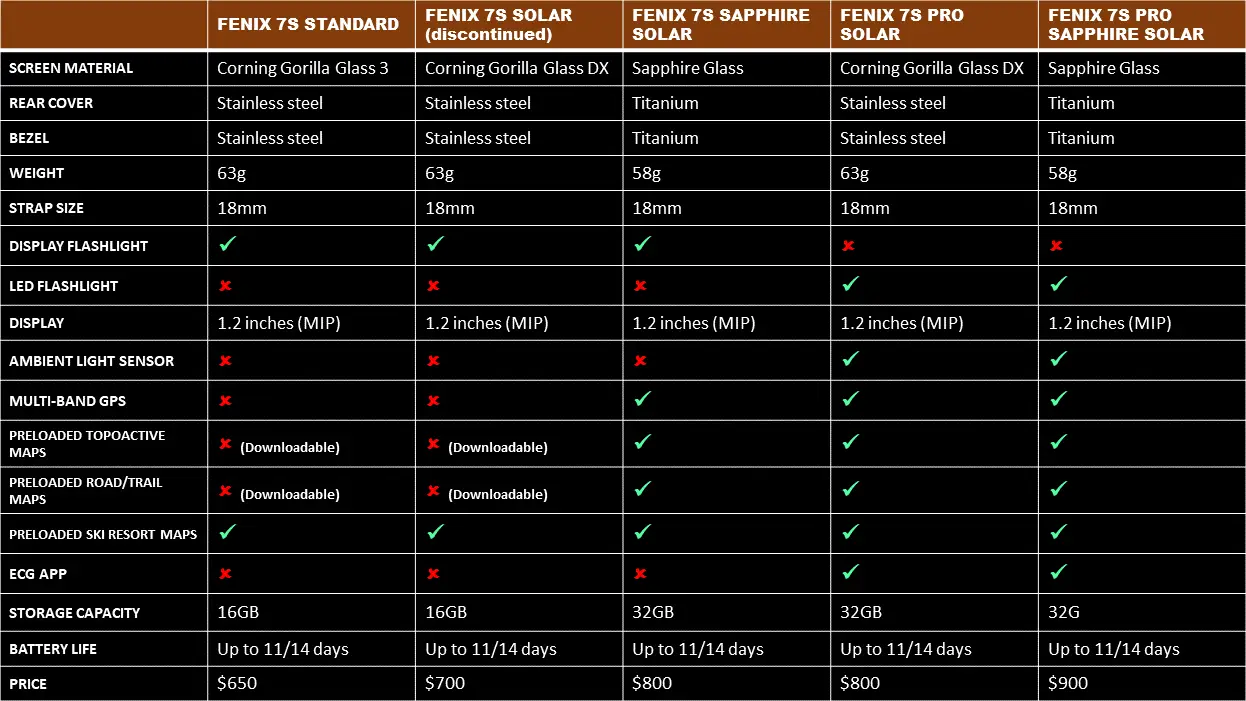
Like I mentioned earlier, the Fenix 7S comes in five models;
- Fenix 7S standard – ($650)
- Fenix 7S Solar (discontinued) ($700)
- Fenix 7S Sapphire Solar – ($800)
- Fenix 7S Pro Solar – ($800)
- Fenix 7S Pro Sapphire Solar – ($900)
Fenix 7 models
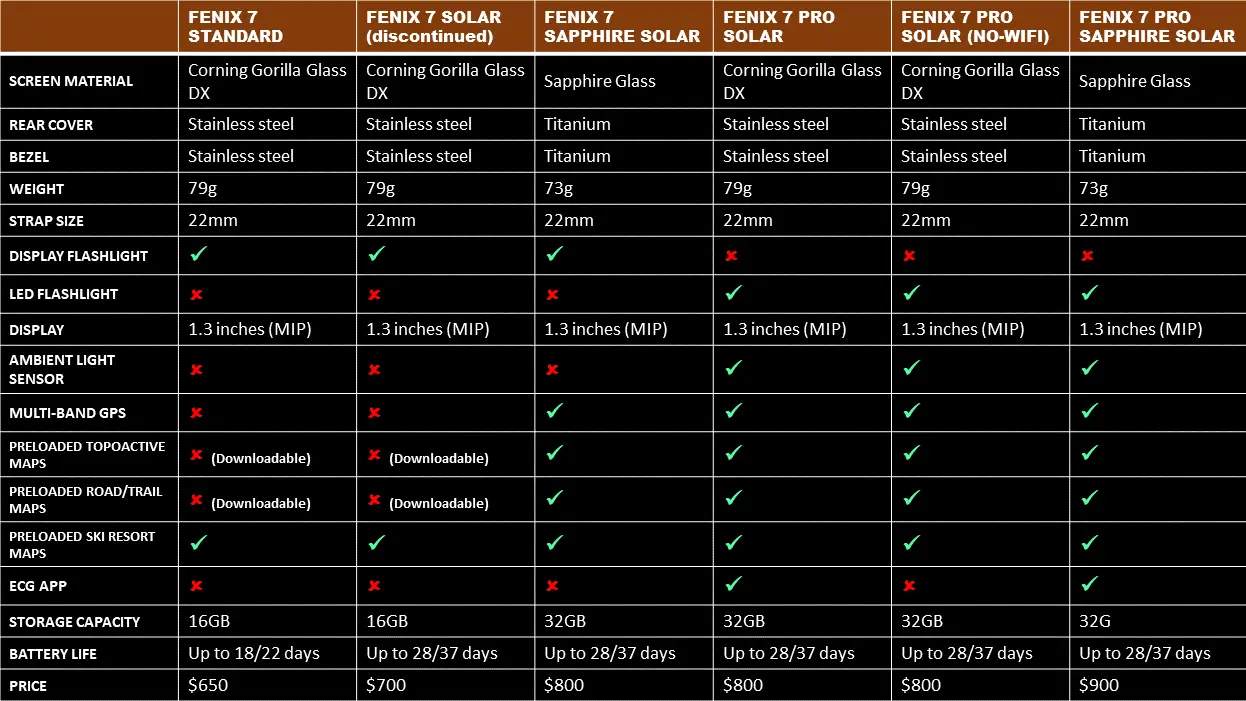
Meanwhile, the Fenix 7 is available in 6 models;
- Fenix 7 Standard – ($650)
- Fenix 7 Solar (discontinued) – ($700)
- Fenix 7 Sapphire Solar – ($800)
- Fenix 7 Pro Solar – ($800)
- Fenix 7 Pro Solar (no-Wi-Fi) – ($800)
- Fenix 7 Pro Sapphire Solar – ($900)
Fenix 7X Models
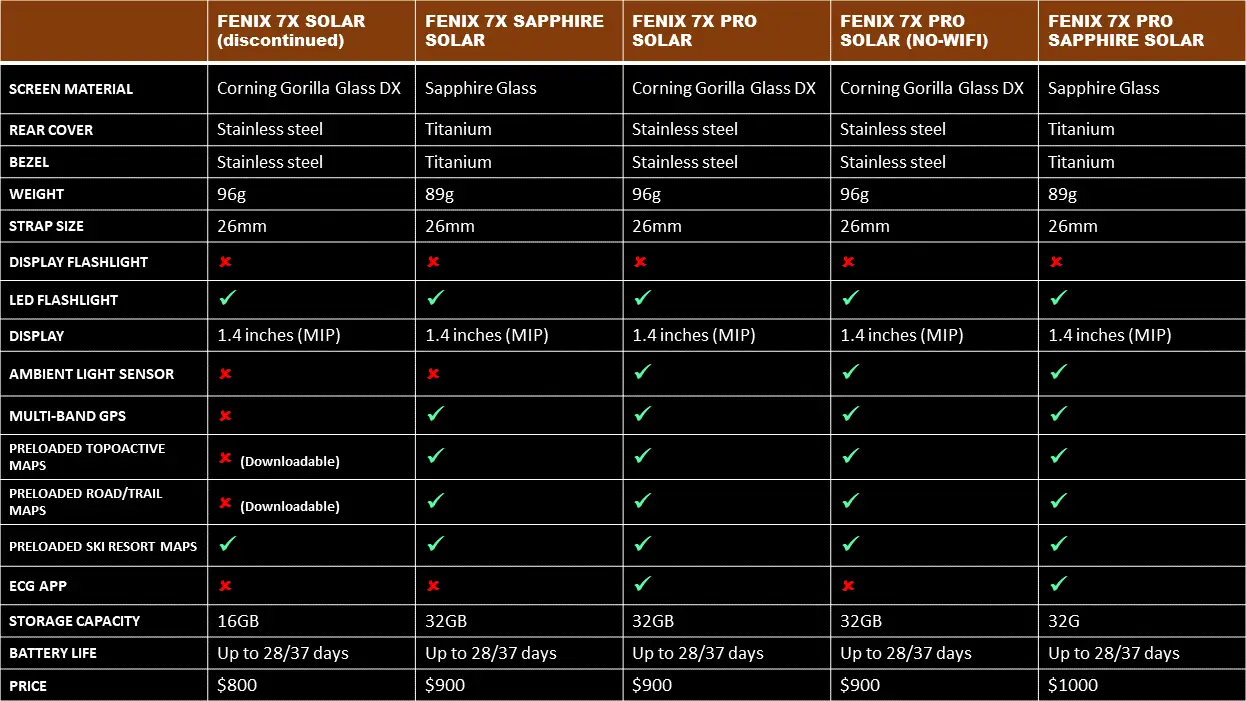
And for the Fenix 7X Pro, you have 5 models which include;
- Fenix 7X Solar (discontinued)
- Fenix 7X Sapphire Solar
- Fenix 7X Pro Solar
- Fenix 7X Pro Solar (no-Wi-Fi)
- Fenix 7X Pro Sapphire Solar
Standard vs Solar vs Sapphire Solar vs Pro Solar vs Pro Solar (no-Wi-Fi) vs Pro Sapphire Solar
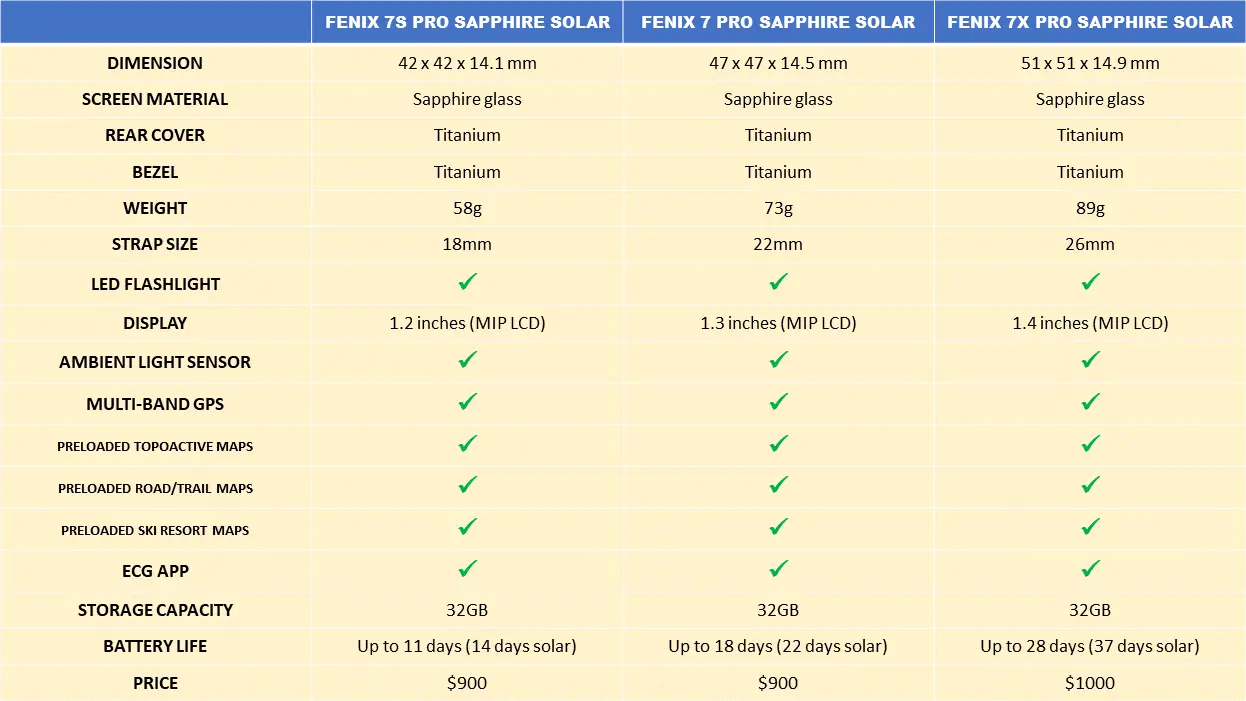
There’s not much difference between the different models. It is the same activity tracking features for all the models. It is the same memory-in-pixel (MIP) display, and all models have touch-sensitive displays. However, the Standard and Solar models which are the base models lack multi-band GPS and have a lower 16GB storage. Moreover, while they have preloaded ski-resort maps, they don’t come with preloaded TopoActive maps, and road and trail maps. You will have to download those maps yourself. It’s important to note that Garmin has discontinued the base solar model, though you might still find it in some retail shops.
Meanwhile, the Sapphire Solar models are more expensive than the Standard and Solar models. This is because they have a more durable build, higher storage (32GB), supports multi-band GPS and come with preloaded TopoActive, road/trail and ski resort maps.
On the other hand, the Pro models being relatively newer are equipped with the more advanced Garmin Elevate v5 heart rate sensor which boasts 6 LED lights compared to the 2 LED lights in the Elevate v4 sensor that powers the other models. As a result, it ensures better accuracy, especially during exercises and enables the new ECG app that will allow you to take ECG tests directly from your wrist.
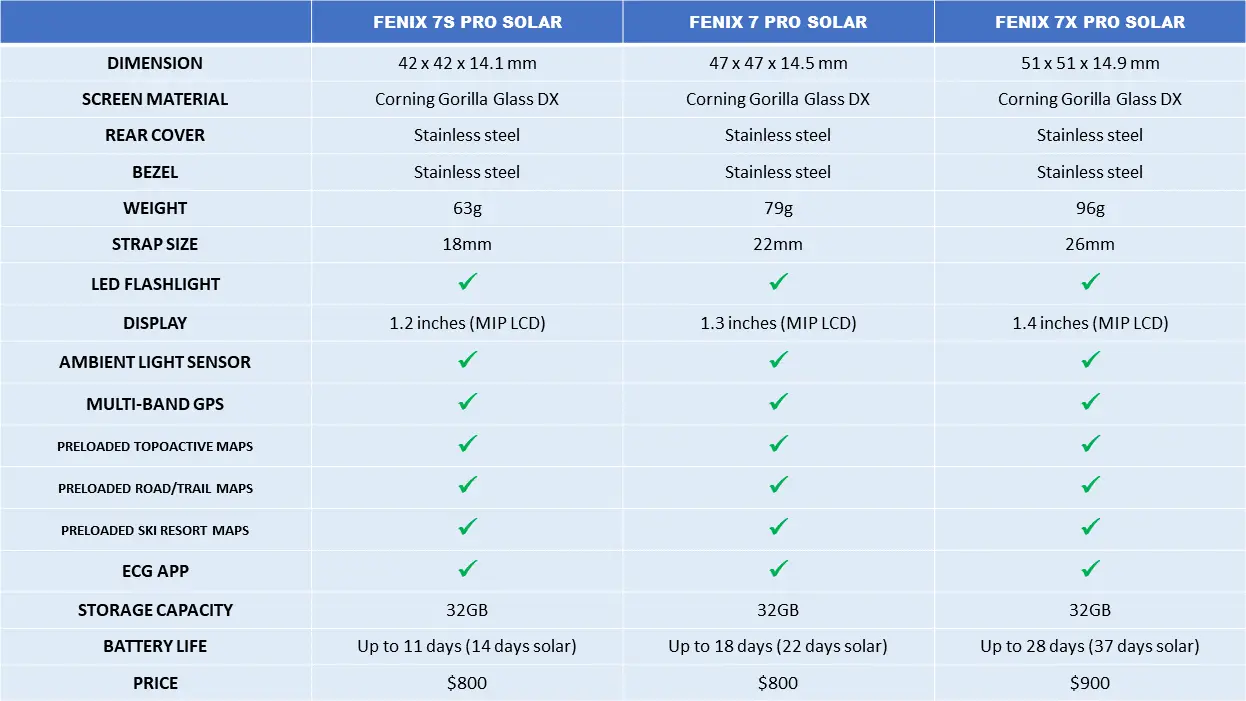
The Pro models are also equipped with an ambient light sensor that allows the display to automatically brighten based on the prevailing environment light. They also have the LED flashlight that was before restricted to only the Fenix 7X models.
There is now a Pro no-Wi-Fi model, we saw this last with the Fenix 6 but Garmin decided to reintroduce it. This model has similar features to other Pro models, however, it lacks Wi-Fi. As a result, you can’t download music from supported music streaming services, you can’t download maps over Wi-Fi, nor does it have the ECG app. Music and maps can only be added from your computer via the Garmin Express app. The Pro no-Wi-Fi model is clearly designed for folks who work in top secret agencies like the CIA and co. The Pro (no Wi-Fi) models only come in 47mm and 51mm case sizes.
While the Pro models all have very similar features, the Pro Sapphire Solar model like the Sapphire Solar model has a superior build quality than the Pro Solar and Pro Solar (no-Wi-Fi) models.
If you look at the prices above, you will notice that the Sapphire Solar, Pro Solar and Pro Solar (no-Wi-Fi) models have the same $800 price tag. This is because while the Sapphire Solar has a more premium build, the Pro models have more features like the ambient light sensor, LED flashlight and ECG. Though the no-Wi-Fi model doesn’t have ECG but that’s totally optional.
So now that you know the differences between the different models, let’s take a look at their technical specifications.
Garmin Fenix 7S Pro vs 7 Pro vs 7X Pro: Specifications Compared
[yith_woocompare_table products=”5717,5884,5902″]
Fenix 7S Standard vs 7S Solar vs 7S Sapphire Solar vs 7S Pro Solar vs 7S Sapphire Solar – Differences
The difference between the respective models in the 7S series comes in the build quality, battery life, storage capacity, color, ECG, multi-band GPS, flashlight and of course price.

All the models of the Fenix 7S are available in the same 42mm case size. Meanwhile, while the Standard and Solar units have a storage capacity of 16GB, the Sapphire, Pro Solar and Pro Sapphire Solar units come with 32GB storage. They also come with preloaded TopoActive maps, trail/road maps and ski resort maps. Moreover, these three support multi-band GPS which means greater mapping accuracy even in difficult terrains such as those with very tall buildings or mountainous terrains.
With the Standard and Solar models, you only get preloaded ski resort maps. However, you can still download other maps of your choice.
In terms of build quality, all the Fenix 7S models have a fiber-polymer frame. However, the 7S Sapphire Solar and 7S Pro Sapphire Solar have a titanium bezel with a titanium rear cover and Sapphire glass protects the display. Meanwhile, the 7S Standard, 7S Solar and 7S Pro Solar have a stainless steel bezel that extends to the rear while Corning Gorilla Glass DX protects the display on these three.
Since titanium is lighter than stainless steel, the 7S Sapphire Solar and 7S Pro Sapphire Solar weigh 58 grams compared to the other three that weigh 63 grams each, that’s 5 grams less.
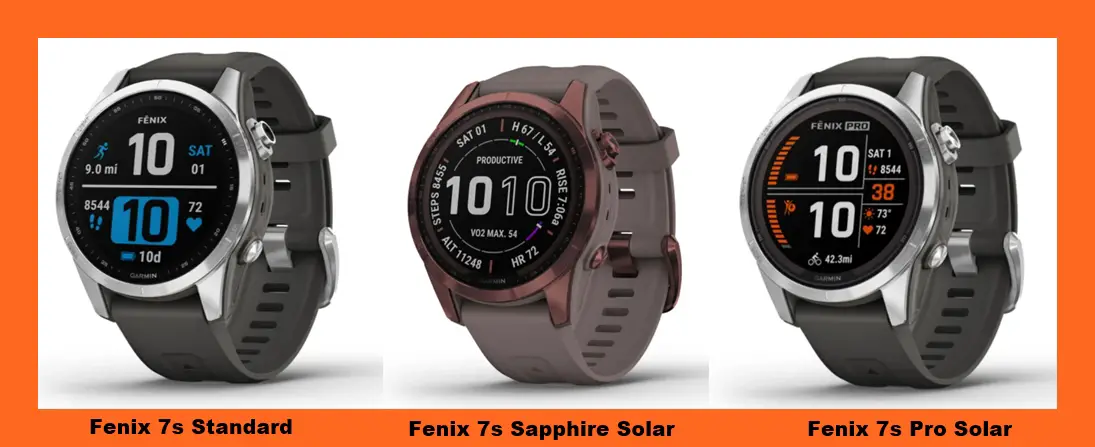
The available colors also differ as shown in the table above. The Fenix 7S Standard is available in slate paired with graphite band while the 7S Solar is available in slate-gray and rose-gold colors.
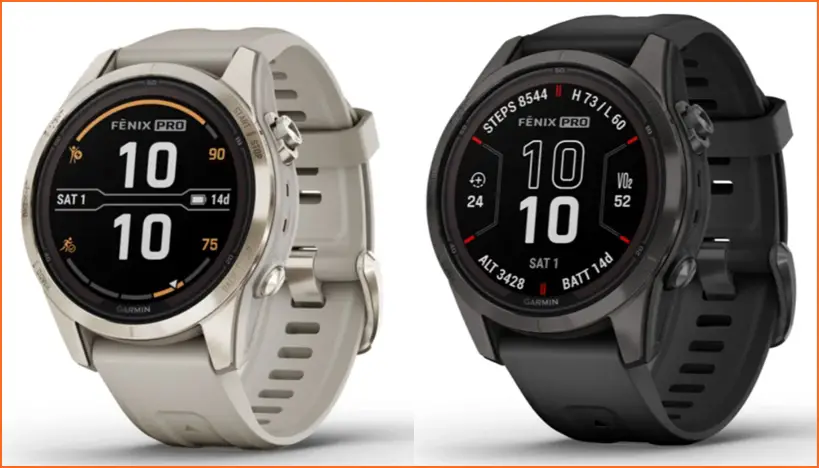
Meanwhile, the 7S Sapphire Solar is available in a dark-bronze frame paired with slate-gray band, the 7S Pro Solar is available in silver and the 7S Pro Sapphire Solar is available in carbon-gray and soft-gold colors.
Just like I mentioned earlier, the Fenix 7S Pro Solar and 7S Pro Sapphire Solar models have the new ECG app. These two also have an ambient light sensor that auto-regulates the brightness of the display. Moreover, you also get a bright LED light that can come in handy if you train at night.
The Fenix 7S Standard and 7S Solar don’t have an LED flashlight but they have a display flashlight. That is, you can turn the display into a flashlight. This is very similar to the flashlight features of the Huawei Band 8 and Galaxy Watch 5 Pro.
As per the battery life, you can get up to 11 days with any of the Fenix 7S models but then with Solar, it’s up to 2 weeks. Thus, you can get up to 11 days with the Fenix 7S standard model and up to 2 weeks with any of the other four.
The prices of the Fenix 7S models also differ. The Fenix 7S Standard being the base model is the cheapest at $650 while the 7S Sapphire Solar and 7S Pro Solar retail for $800. Meanwhile, the 7S Pro Sapphire Solar being the most advanced model, retails for $900.
Beyond these few differences, all the Fenix 7S models have the same features. So it’s up to you to decide your preferred choice based on your preferences.
Fenix 7 Standard vs 7 Solar vs 7 Sapphire Solar vs 7 Pro Solar vs 7 Pro Solar (no-Wi-Fi) vs 7 Pro Sapphire Solar – Differences
The Fenix 7 is available in six different models, each of which comes in a 47mm case size. Moreover, it’s the same fiber-polymer frame. However, just like the Fenix 7S, the Fenix 7 Standard, 7 Solar, 7 Pro Solar and 7 Pro Solar (no-Wi-Fi) models have stainless steel bezels with Corning Gorilla Glass DX protecting the displays.

Meanwhile, the Fenix 7 Sapphire Solar and Fenix 7 Pro Sapphire Solar units have titanium bezel and rear with Sapphire glass protecting the displays. As a result of the lighter titanium material, these two weigh 6 grams less than the other four models.
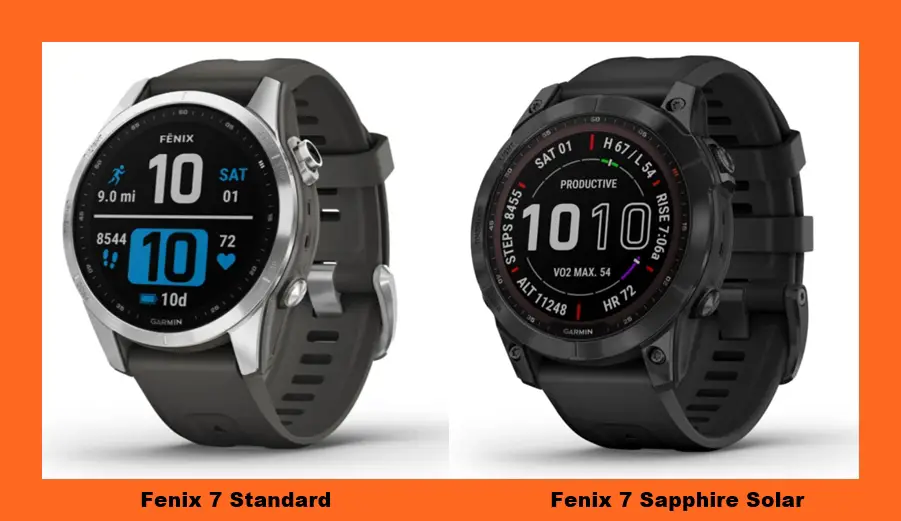
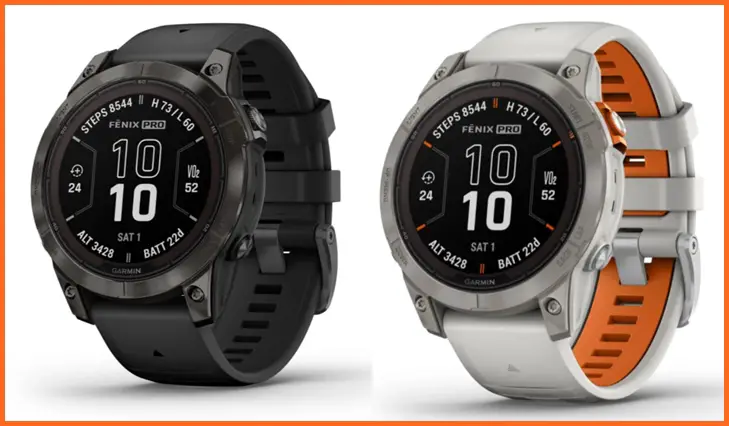
In terms of the available colors, the Fenix 7 base model comes in silver while the 7 Sapphire Solar unit comes in black. On the other hand, the Pro Solar and Pro Solar (no Wi-Fi) models are available in slate gray colors while the 7 Pro Sapphire Solar unit comes in carbon-gray and titanium colors.
Moving on, all the Fenix 7 models come with preloaded ski resort maps, however, only the Fenix 7 Sapphire Solar, 7 Pro Solar, 7 Pro Solar (no Wi-Fi) and 7 Pro Sapphire Solar come with preloaded TopoActive and road/trail maps. Nonetheless, you can still download TopoActive and road/trail maps to the Standard and Solar models. As per storage capacity, while the Fenix 7 Standard and 7 Solar have 16GB storage, the other four have 32GB storage.
Moreover, while the Fenix 7 Standard and 7 Solar lack multi-band GPS, the Fenix 7 Sapphire Solar and the Pro units all support multi-band GPS which guarantees better mapping accuracy. The Pro models being newer have improved heart rate sensor that enables ECG measurement. Though, the Pro (no-Wi-Fi) unit lacks ECG.
The Fenix 7 Pro models also have an LED flashlight which can come in handy during night training. In contrast, the Base, Solar and Sapphire Solar models rely on a display flashlight to help illuminate dark spaces.
According to Garmin, you can expect up to 18 days of battery life with any of the Fenix 7 units, however, the Fenix 7 Solar models have a longer battery life of up to 22 days. In other words, apart from the base model which has 18 days of battery life, it’s up to 22 days with any of the other 5 models.
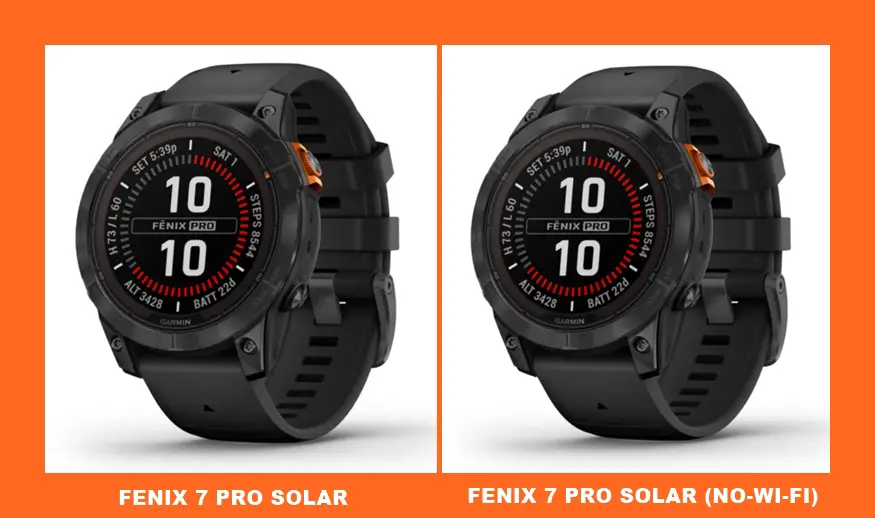
There are also slight differences in the prices. While the base model is the cheapest at $650, the Fenix 7 Pro Sapphire Solar model has the highest price tag of $900. Meanwhile, the Fenix 7 Sapphire Solar, 7 Pro Solar and 7 Pro Solar (no-wifi) units have the same $800 price tag.
So beyond the differences in storage capacity, build quality, price, colors and ECG, all 6 members of the Fenix 7 have the same activity tracking features. Remember, like I stated above, Garmin has discontinued the Fenix 7 Solar unit, though it can still be found in some retail stores.
Fenix 7X Solar vs 7X Sapphire Solar vs 7X Pro Solar vs 7X Pro Solar (no-Wi-Fi) vs 7X Pro Sapphire Solar – Differences
So now you know the differences between the different Fenix 7 models, let’s take a look at the differences between the various Fenix 7X models.
Like the Fenix 7S, the Fenix 7X is also available in five units which include the Fenix 7X Solar, 7X Sapphire Solar, 7X Pro Solar, 7X Pro Solar (no Wi-Fi) and 7X Pro Sapphire Solar. Each of these has a 51mm frame size and the frame material is fiber-polymer. However, the Sapphire models have a titanium bezel with a Sapphire power glass while the other three have stainless steel bezels with a Corning Gorilla DX glass screen. And as a result of the lighter titanium material, the Sapphire units weigh 6 grams less than the other three.

Apart from the now discontinued Fenix 7X Solar with 16GB, the other four models all have 32GB storage. Moreover, while the 7X Solar lacks multi-band GPS support and preloaded TopoActive maps, the other four are equipped with dual-band GPS for improved mapping accuracy and also come with preloaded TopoActive maps. However, as a result of the absence of Wi-Fi in the Fenix 7X Pro Solar (No Wi-Fi) model, maps cannot be downloaded over Wi-Fi. Nonetheless, maps can still be downloaded via the Garmin Express app. Also, you can’t download music from Spotify, Deezer or Amazon Music to the 7X Pro Solar (no-Wi-Fi) unit, this can only be done via the Garmin Express app on your laptop or desktop. Even more is that despite having the Elevate v5 heart rate sensor, the no-Wi-Fi unit unlike the other Pro units lacks ECG.
Moving on, while it’s the same transflective memory-in-pixel (MIP) display for all models, only the Pro units are equipped with an ambient light sensor which auto-regulates the brightness of the display. Meanwhile, besides the Fenix 7X Solar, all the other models have an LED flashlight which is quite helpful if you train at night.
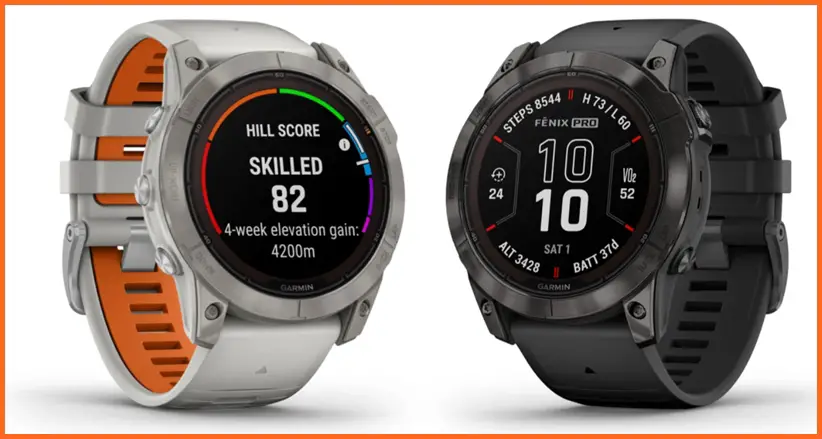
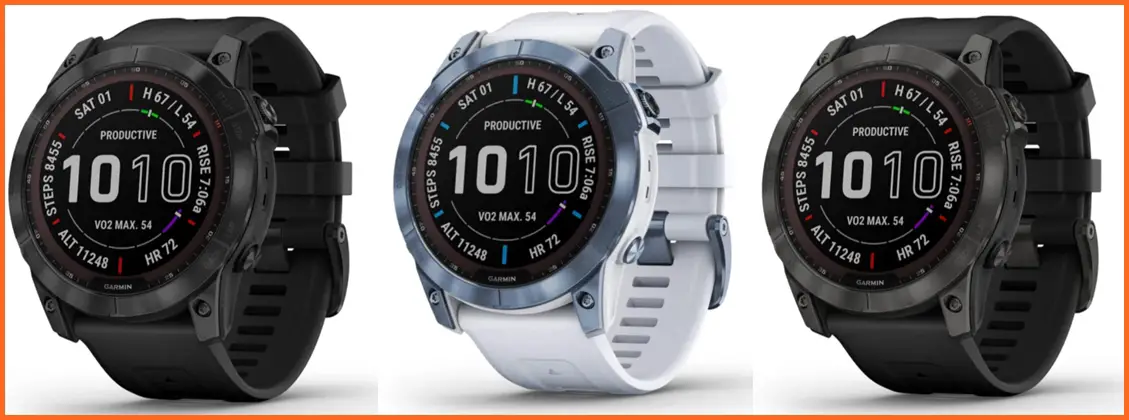
In terms of available colors, while the Fenix 7X Sapphire Solar is available in carbon-gray, blue and black colors, the Fenix 7X Solar, 7X Pro and 7X Pro (no-Wi-Fi) units come in slate gray color. Meanwhile, the 7X Pro Sapphire Solar is available in carbon-gray and titanium colors.
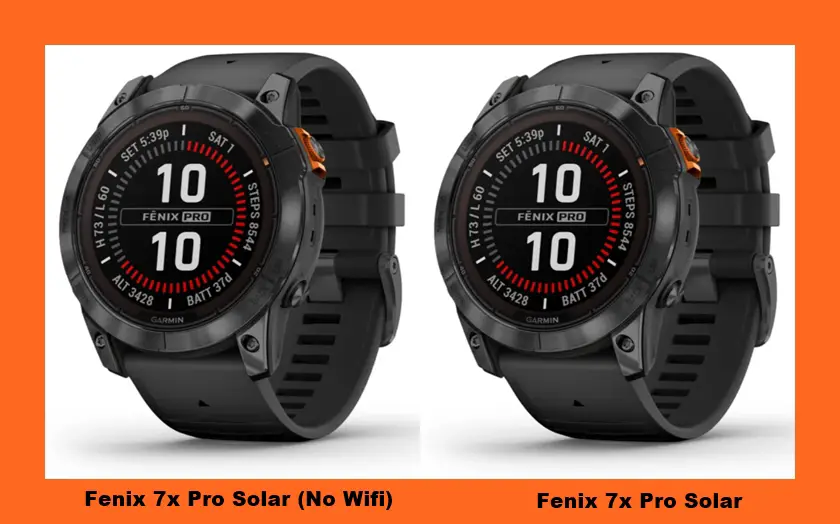
If you choose to settle for the Fenix 7X, then the prices are as follows. The Fenix 7X Sapphire Solar, 7X Pro Solar and 7X Pro Solar (no-Wi-Fi) have a $900 price tag. Meanwhile, the Fenix 7X Pro Sapphire Solar retails for $1000.
Thanks to its big case size, the Fenix 7X boasts a longer battery life than the Fenix 7 and even longer than the Fenix 7S. Garmin claims that with any of the Fenix 7X models you can get up to 28 days of battery life and with the solar capabilities, it’s up to 37 days.
Pro Solar vs Pro Solar (no Wi-Fi)
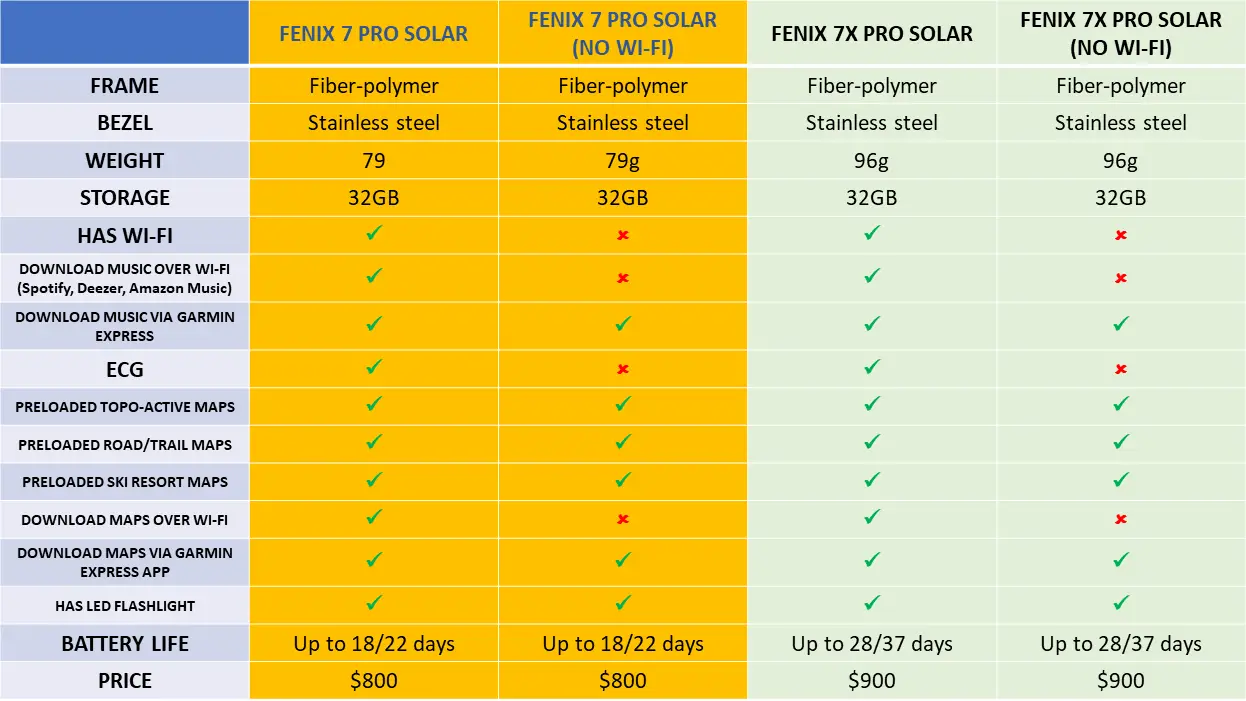
Garmin had introduced the no Wi-Fi version to the Fenix 6, and they have again introduced it to the Fenix 7. The No Wi-Fi model is only available in 47 and 51mm sizes. It has the same features, storage capacity and battery life as the other models but it lacks Wi-Fi. As a result, while it has 32GB storage, music cannot be downloaded over Wi-Fi from Spotify, Deezer or Amazon Music. You can only add music to the watch from the Garmin Express desktop app. Moreover, while it comes with preloaded TopoActive, road/trail and ski resort maps, if you wish to download additional maps, that will only be possible using the Garmin Express app. Meanwhile, maps can be downloaded over Wi-Fi from the Garmin Connect app to the other models.
Last but not the least, the No Wi-Fi model doesn’t have the newly launched ECG app which is available in the other pro models. Beyond these few differences, the No Wi-Fi model has similar features as other Pro models. Nonetheless, despite not having Wi-Fi, the No Wi-Fi model has the same price tag as the Pro Solar.
You may wonder why Garmin would make the same watch without Wi-Fi, well I was confused as well but my findings showed that the No Wi-Fi model is designed for people who work in certain security-conscious agencies where any device with Wi-Fi is not allowed.
Garmin Fenix 7S vs 7 vs 7X – General Differences

Beyond the specific differences between the respective models, let’s take a look at the general differences between the Fenix 7S, 7 and 7X.
Garmin Fenix 7S vs 7 vs 7X – Design Compared
Each model in the Fenix 7 series is durably built with tough materials. All the models have cases made of the usual fiber-polymer material. However, while the Standard, Pro Solar and Pro Solar (No Wi-Fi) models have stainless steel bezels and stainless steel rear covers with Corning Gorilla Glass DX protecting the displays, the Sapphire and Pro Sapphire Solar models have a titanium bezel with a titanium rear cover and Sapphire glass adores the display. From my experience using the Galaxy Watch 5 Pro and Galaxy Watch 4 Classic, I can confidently tell you that Sapphire is really scratch-resistant.
The Sapphire models also weigh a little less than their Standard, Solar and Pro Solar counterparts. Meanwhile, all the models are rated 10ATM, so you can actually wear any of this to the pool, ocean or to shower (though diving from very tall heights might subject these devices to intense pressure, so I won’t recommend it).
In terms of compactness, the Fenix 7X with a case size of 51mm has the biggest case size while the Fenix 7S has the smallest case size at 42mm. Meanwhile, the Fenix 7 has a case size of 47mm. In other words, the Fenix 7S is the most compact. The Fenix 7X also weighs significantly more than the Fenix 7 and Fenix 7S.
The Fenix 7S is no doubt the most comfortable to wear out of these three, and as a result, it’s suitable for individuals with a small wrist size. But then if you have a bigger wrist size, then you might want to look the way of Fenix 7 or Fenix 7X as the case may be.
Garmin Fenix 7S vs 7 vs 7X – Display
Furthermore, the display on all Fenix 7 series is powered by the regular transflective memory-in-pixel display which is quite colorful at 283 PPI and is also very bright and easy to read even under direct sunlight. In fact, even though AMOLED is more colorful, the MIP display is a lot easier to read on a very sunny day.
Navigation has been enhanced as all the Fenix 7S, 7 and 7X models have touch-sensitive screens. This is in addition to 5 physical buttons that makes it easy to navigate the revamped interface. Moreover, there are lots of watch faces to choose from on the Garmin Connect app which is now available onboard the watch.
The Fenix 7X with the biggest footprint has a 1.4 inches display size which is bigger than the 1.3 inches of Fenix 7 and 1.2 inches of Fenix 7S. In other words, you get to see a little more at a glance with the Fenix 7X. Nonetheless, the Fenix 7S display is still very easy to read except perhaps for visually impaired individuals.
And also as I mentioned earlier, the Pro models have an ambient light sensor which auto-regulates the brightness of the display.
Garmin Fenix 7S vs 7 vs 7X – Activity Tracking
Like their respective predecessors, the Fenix 7 series is fully equipped to track your daily activities. Each model is equipped with a heart rate sensor, Spo2, barometric altimeter, gyroscope, accelerometer and thermometer sensors. This enables these watches to track your sleep, heart rate, blood oxygen, calories, steps, floors climbed and many more activities.
The Health Snapshot feature that lets you log a short session of your heart rate, blood oxygen, respiration rate and stress is also available. Onscreen animated workout modes and onscreen animated muscle maps are also available as well as incidental fall detection that lets the watch call preset emergency contacts when it detects a hard fall and your phone is nearby.
Other activity tracking features include the newly added training readiness that gives you a summary of your fitness level for the day. You also get loads of activity profiles which include, Pilates, yoga, HIIT, kiteboard and windsurf sports profiles.
In other words, the Fenix 7 series is perhaps the very best as far as outdoor activity and fitness tracking is concerned.
Garmin Fenix 7S vs 7 vs 7X – Media Storage
As mentioned earlier, all Standard and Solar units come with 16GB storage capacity, while the Sapphire Solar, Pro Solar, Pro Solar (no-Wi-Fi) and Pro Sapphire Solar models come with 32GB storage. You can add your personal music as well as download your playlists from supported services such as Spotify, Deezer and Amazon Music. Then pair your Bluetooth headphone to listen to music offline as none of the units have a speaker. Again, as a result of no Wi-Fi, you can’t download music to the Pro Solar (no-Wi-Fi) model, you can only add music using the Garmin Express app.
Garmin Fenix 7S vs 7 vs 7X – Notifications and Payment
All models in the Fenix 7 series will allow you to manage notifications received on your phone when it’s nearby. Once notification is enabled on the Garmin Connect app, you get a vibration when there is a new text message, Calls, WhatsApp, Gmail notification, or notifications from other apps installed on your phone. And you have the option to reply to notifications with preset quick replies (Android only).
Each of the units also features Garmin Pay – a non-contactless payment system that lets you make payments directly from any of these units by simply storing your card details on the watch.
Garmin Fenix 7S vs 7 vs 7X – Battery Life
Due to its size, the Fenix 7S has the shortest battery life which is still very long when compared to other high-end GPS smartwatches. It is up to 11 days with the Fenix 7S and up to 18 days with the Fenix 7. Meanwhile, the Fenix 7X has the longest battery life of up to 28 days. Moreover, the respective Solar models boast even longer battery life.
So basically apart from the difference in display size and battery life, the Fenix 7S, Fenix 7 and Fenix 7X have similar features.
Garmin Fenix 7S vs 7 vs 7X – Which Model and Size is Right For You?
Clearly, each unit in the Fenix 7 series is well designed with top-notch materials as well as equipped with lots of features.
The right unit for you depends on your wrist size and budget. The Fenix 7S unit which is the most compact is best recommended for women and individuals with a smaller wrist, while the Fenix 7 and 7X models are recommended for men and individuals with a moderate to big wrist size.
The Fenix 7 series is generally not cheap, these are some of the most expensive smartwatches in our catalogue. So, if you have a bigger budget, you can go for the Solar models which offer longer battery life than their Standard counterparts.
And if you want more durable materials then the Sapphire Solar models are no doubt the very best.
Moreover, if you want features like ECG, ambient light sensor and LED flashlight, then the Pro model is an awesome choice. You will notice that the Sapphire Solar, Pro Solar and Pro Solar (no Wi-Fi) have the same price tag. So obviously, Garmin wants you to choose between more features or a more premium build.
Looking at the Pro Solar (no Wi-Fi) unit, I have seen questions like how it differs from the Pro Solar unit since it’s the same price. Well, as I stated earlier, the Pro Solar (no Wi-Fi) has the same features as the Pro Solar model, however, it lacks ECG and maps and music can only be downloaded from the Garmin Express app. Clearly, the Pro Solar (no-Wi-Fi) unit is designed for individuals who work in a highly secure environment where any device with Wi-Fi is barred.
In all, the unit you choose would depend on your wrist size and budget. It’s your call, you decide.
FAQs
What’s the difference between a Fenix 7 and 7X?
The differences between the Fenix 7 and 7X come in the sizes, prices, battery life and available units. The Fenix 7X has a bigger case size than the Fenix 7. It also has a 1.4 inches display compared to 1.3 inches of Fenix 7. Moreover, the Fenix 7X has a longer battery life of 28 days compared to 18 days with the Fenix 7.
And while the Fenix 7X is available in 5 models, the Fenix 7 is available in 6 models.
Which Garmin Fenix 7 is best?
The Fenix 7S Pro Sapphire, Fenix 7 Pro Sapphire Solar and Fenix 7X Pro Sapphire Solar models are the best. These models offer the most features.
How big is the Fenix 7X?
The Fenix 7X measures 51 x 51 x 14.9 mm, so it’s a bulky and thick smartwatch. However, it has the longest battery life of all the Fenix 7 series units
Does Fenix 7 have touch screen?
Yes, all the Fenix 7 series units have touch-screen support. This is the first Fenix smartwatch to have a touch-sensitive display which in addition to 5 physical buttons and the revamped interface makes navigation a lot easier.
Can you answer calls on Garmin Fenix 7?
No, you can’t answer calls on the Fenix 7. The Fenix 7 lacks a loudspeaker and microphone, as a result, it can’t make or receive calls. You can only receive call notifications which you can answer on your phone.
If you want a Garmin watch with the ability to receive and answer calls, then see the Venu 3.
Does Fenix 7 have maps?
Yes, every unit in the Fenix 7 series has preloaded maps. Although, while the Sapphire and Pro units come with preloaded TopoActive, road/trail and ski resort maps, the Standard and Solar units only come with preloaded ski resort maps. However, you have the option to download more maps using the built-in map manager app or from the Garmin Express desktop app.

